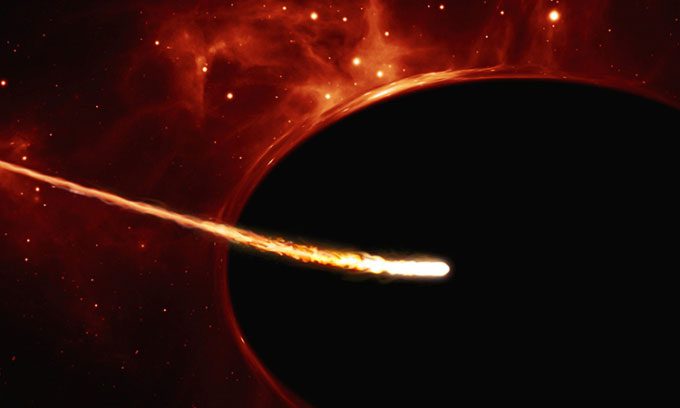The star S4716 takes only 4 years to complete an orbit around Sagittarius A* – the supermassive black hole with an estimated diameter of 23.5 million km.
Astronomers have discovered the fastest star ever recorded, orbiting around Sagittarius A* – the supermassive black hole at the center of the Milky Way with an estimated diameter of 23.5 million km. This new research was published in the Astrophysical Journal on July 5.

Illustration of a star flying quickly around a supermassive black hole. (Image: ESO/ESA/Hubble, M. Kornmesser)
The newly discovered star is named S4716, completing an orbit around the black hole in just about 4 years. This means it is moving at an incredibly high speed, approximately 29 million km/h or 8,000 km per second.
In this orbit, S4716 comes as close to the black hole as 100 AU (1 AU is about 150 million km, roughly the average distance between the Earth and the Sun). This distance is still relatively close when considered in the vastness of the universe. The Sun orbits Sagittarius A* at a distance of about 26,000 light-years, with each light-year equivalent to 9.5 trillion km.
S4716 is part of a dense group of stars known as the S cluster, which orbits the galactic center and the supermassive black hole of the Milky Way. The stars in this cluster all move extremely fast but vary in brightness and mass.
The discovery of this new star very close to Sagittarius A* could change our understanding of the evolution of the Milky Way, especially regarding fast-moving stars in the central region.
“The short orbit of S4716 is quite puzzling. Stars cannot easily form near black holes. S4716 must have moved inward, for example, by approaching other stars and objects in the S cluster, significantly narrowing its orbit,” said astrophysicist Michael Zajaček from Masaryk University (Czech Republic).
Florian Peissker, an astrophysicist at the University of Cologne (Germany), is a co-author of the new study. By continuously improving analytical techniques and combining them with observational data collected over 20 years, he and his colleagues confirmed the extremely rapid orbital period of S4716. Five telescopes were used to monitor S4716, including NIR2 and OSIRIS from the Keck Observatory, as well as SINFONI, NACO, and GRAVITY from the Very Large Telescope system. These provided detailed data about the new star.
“The fact that a star can maintain a stable and fast orbit so close to a supermassive black hole is completely surprising, indicating the limits that can be observed with traditional telescopes,” Peissker noted.





















































